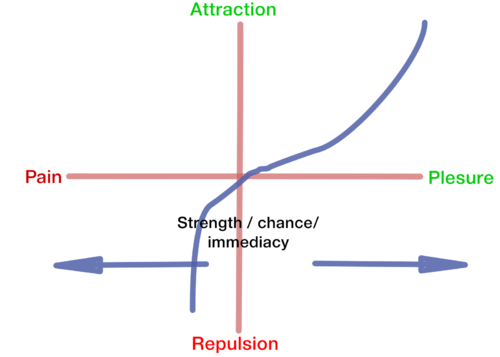Difference between revisions of "Neuronal decision making model"
From Deliberative Democracy Institiute Wiki
(→Basic Mechanism) |
(→Basic Mechanism) |
||
| Line 8: | Line 8: | ||
For every [[node]] in a path, there are several [[implications]]. Every implication is attached at the end of it to a reward in the reward system. | For every [[node]] in a path, there are several [[implications]]. Every implication is attached at the end of it to a reward in the reward system. | ||
| − | The [[value]] of the reward is signaled by the plesentness or pain of the reward | + | ===Value=== |
| + | The [[value]] of the reward is signaled by the plesentness or pain of the reward. The magnitude of the reward will be determined by the volume of the of nuronal signaling that is connected to the reward and the intensety of nuronal firing. The amount of siganling, is due to the learning process [[LTP]] and [[STP]]. It will be composed of the chance for the expected results, and the immdiacy. the higher the chances, and the more immidate the results is axpected to be, the stronger the signal will be. | ||
| + | |||
| + | Pain and plesure are not equal. For most of the people, pain will cause more repalsion then plesure will cause attraction. This is due to the hazardous nature of pain. This may be the neuronal mechanism behind [https://en.wikipedia.org/wiki/Loss_aversion loss aversion]. | ||
[[File:Attraction.png|500px|center|The reward-attraction function model]] | [[File:Attraction.png|500px|center|The reward-attraction function model]] | ||
| Line 14: | Line 17: | ||
The reward attraction function seems to be the basic mechanisms of the [https://en.wikipedia.org/wiki/Prospect_theory prospect theory]. | The reward attraction function seems to be the basic mechanisms of the [https://en.wikipedia.org/wiki/Prospect_theory prospect theory]. | ||
| − | + | It seems that educed connection between implication and reward. The strength will be produced according to the learning rules of | |
[[File:Neural network two paths implications.jpg|500px|thumb|center]] | [[File:Neural network two paths implications.jpg|500px|thumb|center]] | ||
Revision as of 10:39, 20 June 2014
|
This page is a stub. It is not ready for publication and is used to aggregate information about a subject. You can add further reading and add information to the page. If you want to prepare this page for publication please consults with the creator of this page. |
Contents
[hide]Basic Mechanism
The personal mechanism of decision making is based on evaluative neural network (ENN). ENN has two or more paths for reaching a goal.
For every node in a path, there are several implications. Every implication is attached at the end of it to a reward in the reward system.
Value
The value of the reward is signaled by the plesentness or pain of the reward. The magnitude of the reward will be determined by the volume of the of nuronal signaling that is connected to the reward and the intensety of nuronal firing. The amount of siganling, is due to the learning process LTP and STP. It will be composed of the chance for the expected results, and the immdiacy. the higher the chances, and the more immidate the results is axpected to be, the stronger the signal will be.
Pain and plesure are not equal. For most of the people, pain will cause more repalsion then plesure will cause attraction. This is due to the hazardous nature of pain. This may be the neuronal mechanism behind loss aversion.
The reward attraction function seems to be the basic mechanisms of the prospect theory.
It seems that educed connection between implication and reward. The strength will be produced according to the learning rules of
Elements Influencing ENN
FFFF and exploitation will heighten the threshold for using paths, therefore only strongest path will be used. If there aren't very strong paths available, no path will be selected, and the decision making system will freeze. The strongest path will be produced by conducting more repetitions in this path relative to other paths. PFC and exploration on the other side of the scale will reduce the threshold, and therefore will enable a larger variety of options. the option that will be selected will be the one with the most rewards in non-self control mode. In self-control mode, a grater rewards in the future will be preferred to immediate high rewards.
RPE will produce lower the threshold even more, which will result even higher diversity in the paths.
Inducing changes in the Threshold of the Paths
When a person is in a feeling of threat, it will activate FFFF, that will lower the threshold. Any attack on the ego, can produce feeling of attack.


